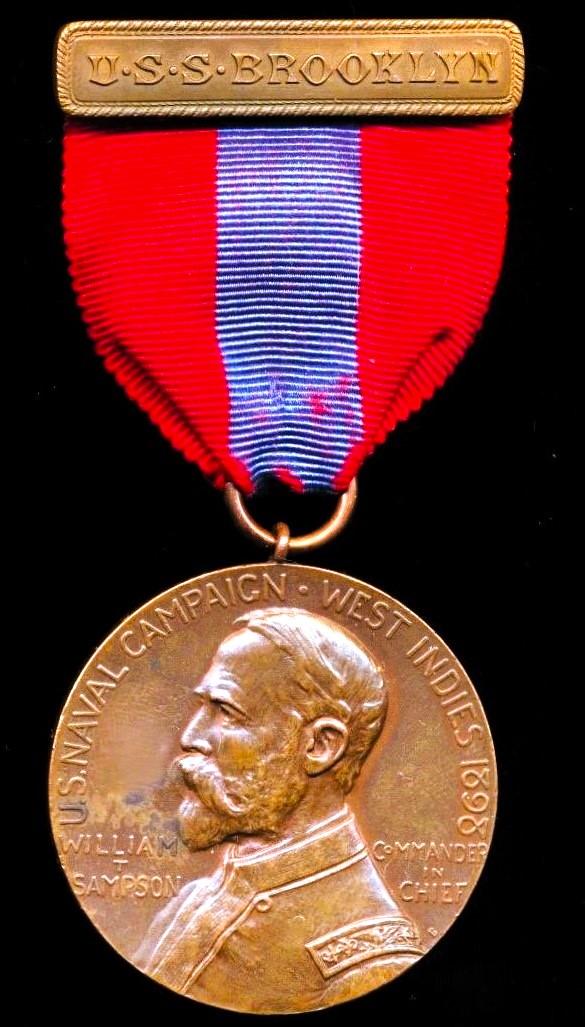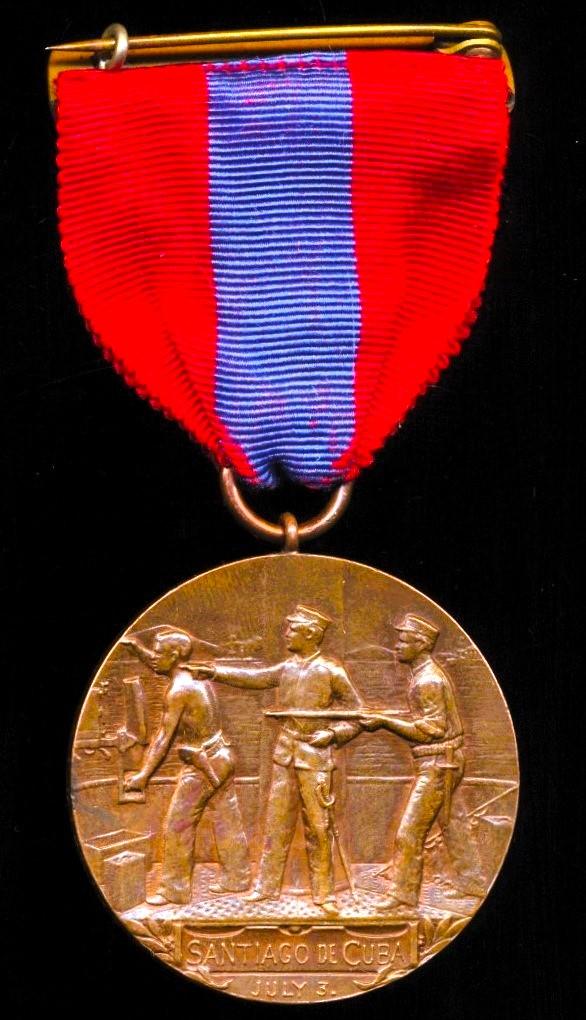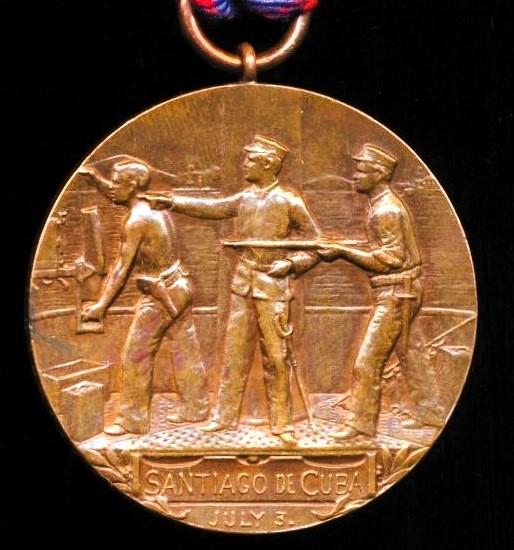United States: West Indies Naval Campaign Medal (Sampson Medal) 1898. 'Santiago De Cuba July 3' reverse. No clasp, complete with integral top brooch bar 'U.S.S. Brooklyn'. Officially impressed naming (George J. McNamara, App. 2d. C.)
A most interesting Naval recipient, to a United States Navy sailor of Irish descent, who is latterly confirmed as serving aboard the 'Gunboat', U.S.S. Alvarado
The U.S.S. Alvarado, was built at, Clyde, Scotland, as a 'Gunboat' for the Spanish Navy, for intended deployment to the Philippines Islands. In the event the 'Alvarado' was deployed to Cuba, where on 17 July 1898 it was captured intact by the United States Navy. Subsequently re-commissioned in the United States Navy on, 4 August 1898. On it's commissioning the entire crew was drawn from the crews of 'other' USN Navy ships in theatre, and subsequently took part in the naval action at 'Manzanillo', on 12/13 August 1898 - the final naval action of the Spanish American War in Cuba
Medal verification: Reference the Sampson Medal Roll article by Dan Farek, published in the 'Journal' of the Orders and Medals Society of America, Volume 31 No.11 November 1980 . The article shows that there were only 25 members of the crew of the U.S.S. Alvarado on the 'Sampson Medal Roll', for this gunboat. The recipient George J. McNamara, Apprentice. 2d. Class, is included in the nominal roll. Clearly the recipient had earlier mustered on U.S.S. Brooklyn to have initially qualified for the medal with reverse 'Santiago De Cuba, July 3', and was later posted to the crew of the captured former Spanish Gunboat, 'Alvarado', that was re-commissioned as the U.S.S. Alvarado. The article referred to claims that all the medals issued to the 'Alvarado' were issued with no clasp medals. The medal here offered being exactly as issued, retaining its original finely stitched riband, and original top clasp bar.
On 5 August 1898, the 1st Marine Battalion (U.S.M.C.) popularly referred to as 'Huntington's Marines' - a bow to their Commanding Officer, and fresh form their victory at Guantanamo, boarded the Army transport U.S.S. Resolute. On 9 August, under convoy of the U.S.S. Newark, U.S.S. Hist, U.S.S. Osceola, U.S.S. Suwanee, and accompanied by the captured Spanish Gunboat 'U.S.S. Alvarado', departed Guantanamo Bay. The 14th Marine's new assignment was to capture the town of Manzanillo located on the coast northwest of Guantanamo Bay
On 12 August, the U.S. Naval Squadron reached its destination and dropped anchor a few miles offshore. The 'Gunboat' U.S.S. Alvarado, under a flag of truce, was the ship selected and sent to demand the surrender of Manzanillo. In the event, the surrender request was, due to Spanish military protocol, refused out of hand by the Spanish Commander. The United States ships then began a bombardment of the Spanish shore batteries which ceased in the evening and resumed early the next day. At daybreak the following day, white surrender flags were seen flying from most of Manzanillo’s buildings. The surrender of Manzanillo marked a general armistice in Cuba, and was the final naval engagement of the Spanish American War in Cuba was over
U.S.S. Brooklyn: USS Brooklyn (ACR-3/CA-3) was the third United States Navy armored cruiser, the only one to be named at commissioning for a city rather than a state
Ordered for $3,450,420.29 (hull and machinery) she was launched on 2 October 1895 by William Cramp & Sons Ship and Engine Building Company of Philadelphia; sponsored by Miss Ida May Schieren, daughter of Charles A. Schieren, Mayor of Brooklyn, New York; and commissioned on 1 December 1896, Captain Francis Augustus Cook in command
During the Spanish–American War, the Flying Squadron arrived at Cienfuegos, Cuba on 21 May and established the blockade of that port. On 26 May, the Squadron arrived at Santiago de Cuba, where the Spanish fleet was being held behind the protection of the forts. Brooklyn was a key vessel in the Battle of Santiago de Cuba on 3 July, in which the Spanish Fleet was destroyed. Although she was struck 20 times by whole shot, Brooklyn suffered only one man wounded (Fireman J. Bevins) and one man killed (Chief Yeoman George Henry Ellis
An extremely interesting and desirable 'Sampson Medal', of which no more than 25 x United States Navy personnel recipients subsequently served aboard the 'Gunboat' U.S.S. Alvarado at the final engagement of the Spanish American War in Cuba at Manzanillo
Condition: About EF
Code: 23875







